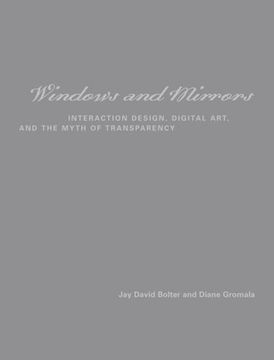Compartir
Windows and Mirrors - Interaction Design, Digital Art, and the Myth of Transparency (Leonardo) (en Inglés)
Jay David (Wesley Chair Of New Media Bolter (Autor)
·
Mit Press
· Tapa Blanda
Windows and Mirrors - Interaction Design, Digital Art, and the Myth of Transparency (Leonardo) (en Inglés) - Jay David (Wesley Chair Of New Media Bolter
64,17 €
67,54 €
Ahorras: 3,38 €
Elige la lista en la que quieres agregar tu producto o crea una nueva lista
✓ Producto agregado correctamente a la lista de deseos.
Ir a Mis Listas
Origen: Estados Unidos
(Costos de importación incluídos en el precio)
Se enviará desde nuestra bodega entre el
Miércoles 19 de Junio y el
Lunes 08 de Julio.
Lo recibirás en cualquier lugar de España entre 1 y 5 días hábiles luego del envío.
Reseña del libro "Windows and Mirrors - Interaction Design, Digital Art, and the Myth of Transparency (Leonardo) (en Inglés)"
The experience of digital art and how it is relevant to information technology. In Windows and Mirrors: Interaction Design, Digital Art, and the Myth of Transparency, Jay David Bolter and Diane Gromala argue that, contrary to Donald Norman's famous dictum, we do not always want our computers to be invisible "information appliances." They say that a computer does not feel like a toaster or a vacuum cleaner; it feels like a medium that is now taking its place beside other media like printing, film, radio, and television. The computer as medium creates new forms and genres for artists and designers; Bolter and Gromala want to show what digital art has to offer to Web designers, education technologists, graphic artists, interface designers, HCI experts, and, for that matter, anyone interested in the cultural implications of the digital revolution. In the early 1990s, the World Wide Web began to shift from purely verbal representation to an experience for the user in which form and content were thoroughly integrated. Designers brought their skills and sensibilities to the Web, as well as a belief that a message was communicated through interplay of words and images. Bolter and Gromala argue that invisibility or transparency is only half the story; the goal of digital design is to establish a rhythm between transparency-made possible by mastery of techniques-and reflection-as the medium itself helps us understand our experience of it. The book examines recent works of digital art from the Art Gallery at SIGGRAPH 2000. These works, and their inclusion in an important computer conference, show that digital art is relevant to technologists. In fact, digital art can be considered the purest form of experimental design; the examples in this book show that design need not deliver information and then erase itself from our consciousness but can engage us in an interactive experience of form and content.

